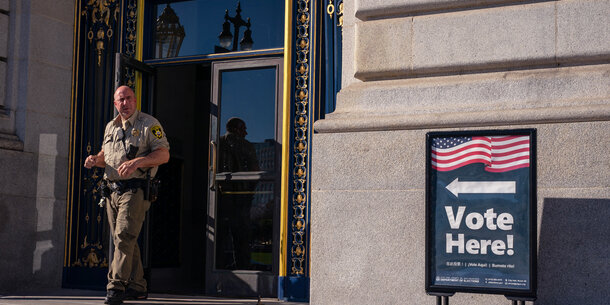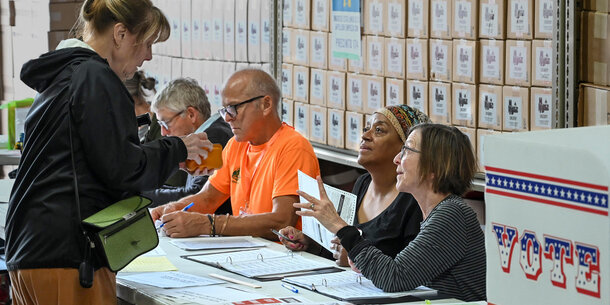Washington, D.C. – The Alliance for Securing Democracy (ASD) at the German Marshall Fund of the United States and the Brennan Center for Justice at NYU Law today launched the Midterm Monitor, an interactive tool designed to capture voting and election messaging from a select group of candidates, U.S. media, and foreign state-backed sources across multiple social media platforms. The monitor allows users to track election narratives and better understand those messages.
Designed for academics, election officials, journalists, researchers, and other interested individuals, the Midterm Monitor has been collecting data since early summer and already includes close to 40,000 posts related to voting and elections. The tool lets users explore its data based on geography, source, platform, language, and more. The dashboard also offers a menu of filters for election-related search terms, such as “ballots,” “vote by mail,” and “election security,” to help users put together a fuller picture of the conversation around voting and election administration.
MIDTERM MONITOR DETAILS: The Midterm Monitor collects posts and metrics from Facebook, Instagram, Twitter, and YouTube accounts affiliated with candidates for the U.S. House, U.S. Senate, and candidates for governor and secretary of state. The monitor also collects posts and metrics from accounts affiliated with influential national media outlets and pundits, most-followed local media outlets in 10 battleground states, non-English language U.S. media outlets, Spanish-language U.S. media outlets, and state media and diplomats associated with the Chinese, Iranian, and Russian governments.
Read the full methodology here.
WHAT RESEARCHERS ARE WATCHING AND FINDING SO FAR THIS ELECTION SEASON
Analysts from ASD and the Brennan Center have been examining and will continue to examine emerging narratives on several key topics this election season, such as election denialism, the Spanish-language information space, and more. So far, analysts have learned the following:
- Threats to democracy. Polls show this is a top concern among voters, and initial data from the monitor indicates some agreement across party lines that democracy is under threat, though the why and how may differ. Early monitor findings show that, between July 1 and September 5, 2022, 196 tweets by U.S. political candidates mentioned variations of the phrase “threat to democracy.” More than a quarter were posted after President Biden’s September 1 speech on democracy. Seventy-five percent (147 of the 196 tweets) were by Democratic candidates.
Between July 1 and August 31, more than half of the 117 tweets from Democratic candidates that mentioned variations of the phrase “threat to democracy” framed the source of the threat as the Republican party, former president Trump, the candidates’ opponents, or a combination of the three. Of the 16 tweets by Republican candidates in that time frame, seven focused on censorship of conservatives on social media or criticized the “liberal media.”
- Voting and election administration. The laws, policies, and processes surrounding voting have been the subject of unprecedented attention since the 2020 election. Initial monitor data shows more than 600 tweets mentioning voting laws, 270 tweets referencing voting machines, and more than 150 tweets about voter suppression since August 1, 2022. Analysts will continue to track key terms in election administration across platforms, party, state, and specific races.
- Foreign interference in elections. In 2016 and 2020, we saw foreign state-backed actors like Russia and Iran seek to interfere in U.S. elections through information operations (among other tactics). While the U.S. government concluded that China considered it but decided not to interfere in the 2020 election, the intelligence community has recently issued warnings of China’s campaigns to influence U.S. state and local leaders. Initial monitor data shows that claims by U.S. accounts of election meddling and interference have largely focused on domestic, not foreign, threats. In candidate tweets between July 1 and August 31, 2022, mentioning the terms “meddle” or “meddling,” only one tweet mentioned a foreign adversary, and it claimed that the FBI and Facebook were more responsible for meddling in the 2020 election than Russia. In the same time period, the U.S. media accounts tracked on the monitor posted at least 29 tweets about steps taken by the U.S. government or private companies to combat foreign interference. Of those tweets, there were at least six tweets by media accounts that mentioned a State Department reward for information about Russian interference in the midterms.
ADDITIONAL RESOURCES:
Read about the methodology here.
Interact with the Midterm Monitor here.
Read ASD’s latest work on the midterm elections here.
Read more about the Brennan Center’s work on election security here and voting here.
For information about voting and elections in Spanish, visit Brennan en español here.
Reporters with questions about Midterm Monitor should reach out to Kayla Goodson at kgoodson@securingdemocracy.org or Rebecca Autrey at autreyr@brennan.law.nyu.edu.
###

